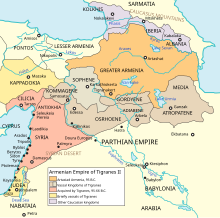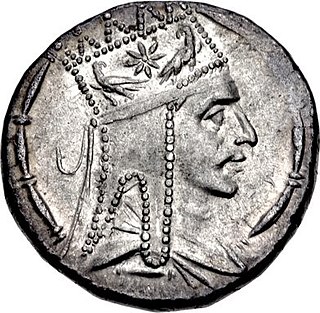
Tigranes II, more commonly known as Tigranes the Great, was a king of Armenia. A member of the Artaxiad dynasty, he ruled from 95 BC to 55 BC. Under his reign, the Armenian kingdom expanded beyond its traditional boundaries and reached its peak, allowing Tigranes to claim the title Great King or King of Kings. His empire for a short time was the most powerful state to the east of the Roman Republic.

Antiochus I Theos Dikaios Epiphanes Philorhomaios Philhellen was king of the Greco-Iranian kingdom of Commagene and the most famous king of that kingdom.

Adiabene was an ancient kingdom in northern Mesopotamia, corresponding to the northwestern part of ancient Assyria. The size of the kingdom varied over time; initially encompassing an area between the Zab Rivers, it eventually gained control of Nineveh and starting at least with the rule of Monobazos I, Gordyene became an Adiabenian dependency. It reached its zenith under Izates II, who was granted the district of Nisibis by the Parthian king Artabanus II as a reward for helping him regain his throne. Adiabene's eastern borders stopped at the Zagros Mountains, adjacent to the region of Media. Arbela served as the capital of Adiabene.
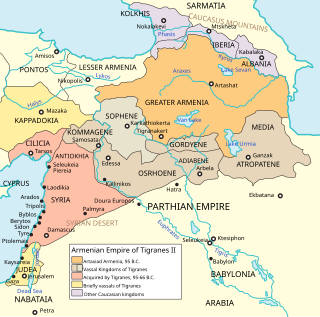
Armenia, also the Kingdom of Greater Armenia, or simply Greater Armenia or Armenia Major sometimes referred to as the Armenian Empire, was a kingdom in the Ancient Near East which existed from 331 BC to 428 AD. Its history is divided into the successive reigns of three royal dynasties: Orontid, Artaxiad and Arsacid (52–428).

Vologases I was the King of Kings of the Parthian Empire from 51 to 78. He was the son and successor of Vonones II. He was succeeded by his younger son Pacorus II, who continued his policies.
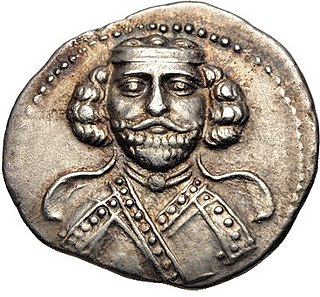
Phraates III, was King of Kings of the Parthian Empire from 69 BC to 57 BC. He was the son and successor of Sinatruces.

Artavasdes II was king of Armenia from 55 BC to 34 BC. A member of the Artaxiad dynasty, he was the son and successor of Tigranes the Great, who ascended the throne of a still powerful and independent state. His mother was Cleopatra of Pontus, thus making his maternal grandfather the prominent Pontus king Mithridates VI Eupator. Like his father, Artavasdes continued using the title of King of Kings, as seen from his coins.

Sophene was a province of the ancient kingdom of Armenia, located in the south-west of the kingdom, and of the Roman Empire. The region lies in what is now southeastern Turkey.
The Arsacid dynasty, called the Arshakuni in Armenian, ruled the Kingdom of Armenia, with some interruptions, from 12 to 428. The dynasty was a branch of the Arsacid dynasty of Parthia. Arsacid kings reigned intermittently throughout the chaotic years following the fall of the Artaxiad dynasty until 62, when Tiridates I, brother of Parthian King Vologases I, secured Arsacid rule in Armenia as a client king of Rome. However, he did not succeed in establishing his line on the throne, and various princes of different Arsacid lineages ruled until the accession of Vologases II, who succeeded in establishing his own line on the Armenian throne, which ruled the kingdom until its abolishment by the Sasanian Empire in 428.
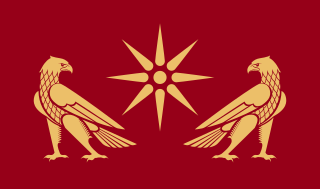
The Artaxiad dynasty ruled the Kingdom of Armenia from 189 BC until their overthrow by the Romans in 12 AD. Their realm included Greater Armenia, Sophene and intermittently Lesser Armenia and parts of Mesopotamia. Their main enemies were the Romans, the Seleucids and the Parthians, against whom the Armenians conducted multiple wars.
The Orontid dynasty, also known as the Eruandids or Eruandunis, ruled the Satrapy of Armenia until 330 BC and the Kingdom of Armenia from 321 BC to 200 BC. The Orontids ruled first as client kings or satraps of the Achaemenid Empire and after the collapse of the Achaemenid Empire established an independent kingdom. Later, a branch of the Orontids ruled as kings of Sophene and Commagene. They are the first of the three royal dynasties that successively ruled the antiquity-era Kingdom of Armenia.

Sames I, was the Orontid king of Sophene and Commagene, ruling around 260 BC.
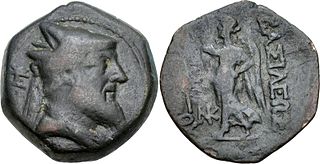
Xerxes was king of Sophene and Commagene from 228 BC to 212 BC. He was the son and successor of Arsames I.

Pontus was a Hellenistic kingdom centered in the historical region of Pontus in modern-day Turkey, and ruled by the Mithridatic dynasty of Persian origin, which possibly may have been directly related to Darius the Great of the Achaemenid dynasty. The kingdom was proclaimed by Mithridates I in 281 BC and lasted until its conquest by the Roman Republic in 63 BC. The Kingdom of Pontus reached its largest extent under Mithridates VI the Great, who conquered Colchis, Cappadocia, Bithynia, the Greek colonies of the Tauric Chersonesos, and for a brief time the Roman province of Asia. After a long struggle with Rome in the Mithridatic Wars, Pontus was defeated. The western part of it was incorporated into the Roman Republic as the province Bithynia et Pontus; the eastern half survived as a client kingdom until 62 AD.
Ptolemaeus was initially the satrap of Commagene, later becoming its first king in 163 BC. He belonged to the Orontid dynasty, founded by Orontes I. Ptolemaeus' father was King Orontes IV of Armenia, son of Arsames I.
Mithridates III Antiochus Epiphanes was a prince who served as a King of Commagene.
Antiochus III Epiphanes was the ruler of the Kingdom of Commagene from 12 BC to 17 AD. He was the son and successor of King Mithridates III of Commagene and Iotapa, and of mixed Iranian, Armenian, Greek and Median descent – the last through his mother. His parents were first cousins.

The Kingdom of Sophene, was a Hellenistic-era political entity situated between ancient Armenia and Syria. Ruled by the Orontid dynasty, the kingdom was culturally mixed with Greek, Armenian, Iranian, Syrian, Anatolian and Roman influences. Founded around the 3rd century BCE, the kingdom maintained independence until c. 95 BCE when the Artaxiad king Tigranes the Great conquered the territories as part of his empire. Sophene laid near medieval Kharput, which is present day Elazığ.

Cappadocia was a province of the Roman Empire in Anatolia, with its capital at Caesarea. It was established in 17 AD by the Emperor Tiberius, following the death of Cappadocia's last king, Archelaus.

Tigranes the Younger was an Artaxiad prince, who briefly ruled the Kingdom of Sophene in 65 BC.
